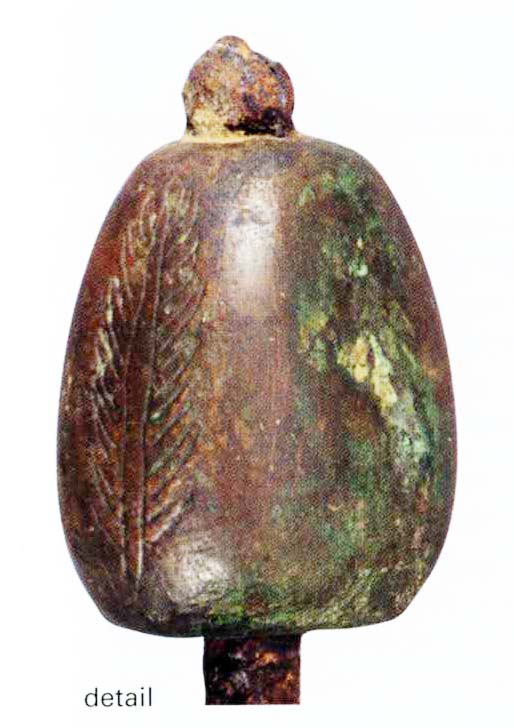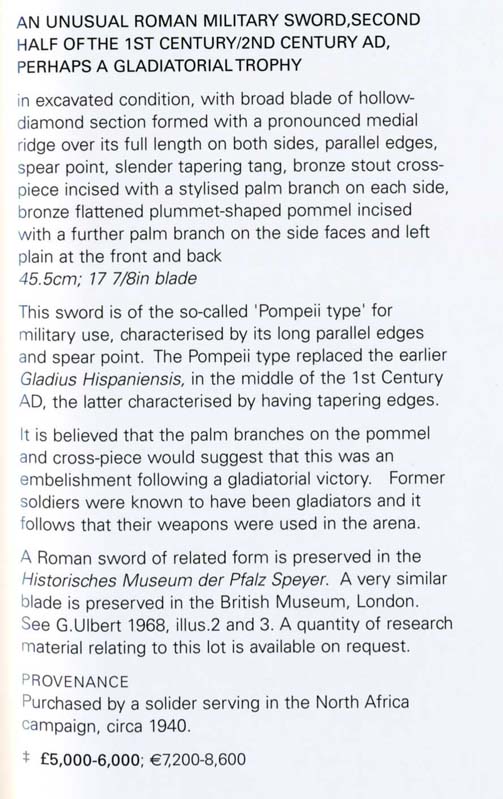I'm curious about how exactly the hilt of a gladius or a spatha was actually put together, but my searches won't yield any good results.
Does anyone possess this information or know where I can find instructions?
Well, assuming you're talking mostly about the first century AD, more or less, my own humble Legio XX site might help:
http://www.larp.com/legioxx/gladius.html
Generally, the hilt consisted of 3 parts: guard, grip, and pommel. Most often the guard and pommel were wood and the grip bone, but all three could be bone and/or ivory, and a few wood grips survive. The guard typically has a thin brass plate set into its face. Like most other swords, the tang ran through all 3 pieces, and was peened over a washer or small brass finial.
Is that what you're looking for? Vale,
Matthew
http://www.larp.com/legioxx/gladius.html
Generally, the hilt consisted of 3 parts: guard, grip, and pommel. Most often the guard and pommel were wood and the grip bone, but all three could be bone and/or ivory, and a few wood grips survive. The guard typically has a thin brass plate set into its face. Like most other swords, the tang ran through all 3 pieces, and was peened over a washer or small brass finial.
Is that what you're looking for? Vale,
Matthew
It's hardly usual or typical, but there is at least one example with a bronze pommel and guard. From a Sotheby's catalogue of December, 2004.
 Attachment: 16.84 KB
Attachment: 16.84 KB

 Attachment: 57.6 KB
Attachment: 57.6 KB

Pommel
 Attachment: 97.97 KB
Attachment: 97.97 KB

Catalogue text


Pommel

Catalogue text
So, these swords were put together pretty much like later medieval European swords, the tang going all the way through the hilt and then peened? Is that about right?
Sure seems that way. That tang seems so narrow, too; I wonder if it was like that in its uncorroded state?
M.
M.
| M. Eversberg II wrote: |
| Sure seems that way. That tang seems so narrow, too; I wonder if it was like that in its uncorroded state?
M. |
That's really no narrower than a number of medieval tangs. It can be narrow and still be plenty strong, provided it is thick enough.
My eyes must deceive me, I guess. Seemed rather diminutive.
M.
M.
"Rat-tail" tangs were common:
http://s129.photobucket.com/albums/p239/mcbis...fig039.png
The hilt on the right is a complete thin silver sheathing, originally over a wooden core. This illustration is from Bishop and Coulston's "Roman Military Equipment", the drawings from which are available online, put there by Mike Bishop himself:
http://romanmilitaryequipment.co.uk/figures.htm
Valete,
Matthew
http://s129.photobucket.com/albums/p239/mcbis...fig039.png
The hilt on the right is a complete thin silver sheathing, originally over a wooden core. This illustration is from Bishop and Coulston's "Roman Military Equipment", the drawings from which are available online, put there by Mike Bishop himself:
http://romanmilitaryequipment.co.uk/figures.htm
Valete,
Matthew
| Chad Arnow wrote: | ||
That's really no narrower than a number of medieval tangs. It can be narrow and still be plenty strong, provided it is thick enough. |
Yeah, with a narrow tang thickness can be important, and if it's substantially thicker than the blade and tapers into the blade shoulders it should be a lot stronger than it looks.
The handle material also add to rigidity over the length of the tang and the most critical point is just at the transition to the blade's shoulders: Stress risers at this point if the corners are cut without at least a small radius or a sudden step down in thickness that happen just at the shoulders would concentrate weakness just at the most stressed point of the handle/blade junction.
Page 1 of 1
You cannot post new topics in this forumYou cannot reply to topics in this forum
You cannot edit your posts in this forum
You cannot delete your posts in this forum
You cannot vote in polls in this forum
You cannot attach files in this forum
You can download files in this forum
All contents © Copyright 2003-2006 myArmoury.com — All rights reserved
Discussion forums powered by phpBB © The phpBB Group
Switch to the Full-featured Version of the forum
Discussion forums powered by phpBB © The phpBB Group
Switch to the Full-featured Version of the forum